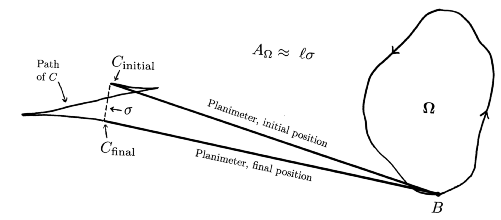
The claim is that the area AW of the region W is given by
AW = l s + ACCW - ACW .
In this formula, l is the length of the planimeter, s is the length of the circular arc joining the initial and final positions of the chisel edge C, ACW is the area of the lower triangle traced clockwise by the chisel edge, and ACCW is the area of the upper triangle traced counterclockwise by the chisel edge.

To understand this, you first need to understand the how a general planimeter works. If a planimeter rod with a wheel moves in such a way that both endpoints traverse closed curves, then the signed area swept out is given by the formula
AR - AL = l s - 1/2 l l 2 Dq .
Here AR and AL are the
signed areas traversed by the right and left endpoints, respectively, l
is the length of the planimeter rod, s is the amount
the wheel rolls, l is
the parameter indicating the location of the wheel along the rod, and
Dq is the net rotation of the rod, which
is a multiple of 2p.
How do we apply this to a Prytz planimeter? Part of this is
obvious -- take the right endpoint to be the tracer point, which goes around W,
and so AR = AW.
But the left endpoint doesn't go around a closed curve, and there's no wheel!
Consider an imaginary wheel attached to the rod at the chisel edge. As the
tracer point traces the boundary of W, the wheel
doesn't turn, because its axis is parallel to the rod. Once the tracer point
has returned to the base point B, imagine rotating the planimeter, moving
the chisel edge from its final position back to its initial position. This would
cause the wheel to roll by s. The left endpoint has
now traversed a closed curve, and the signed area it encloses is and so AL
= ACCW - ACW , and the net rotation is
Dq = 0. Plugging into the
signed are formula above yields
AW + ACW - ACCW = l s ,
which was what we wanted to prove.
This proof is due to O. Henrici.